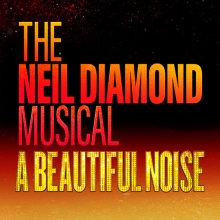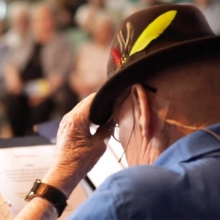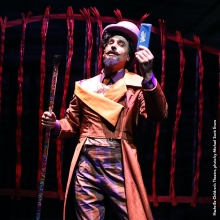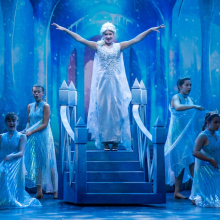Full Synopsis
Full Synopsis
A rocking chair sits onstage; on it are a bell and a book of Mother Goose rhymes. Suddenly, seven lively boys and girls greet us with a welcome to a hootenanny of swingin' Mother Goose rhymes. Nobody really knows the true identity of Mother Goose, so the children present several theories. In the end, it doesn't matter who Mother Goose was, as her stories – which come from all over the world – have a universal, timeless appeal ("Pocketful of Rhymes").
Mother Goose enters and rings the bell, calling the Pocketful of Rhymes to order. She takes roll call, introducing the cast. Then, she explains all of the different kinds of nursery rhymes: there are: lullabies, prayers, love songs, wise sayings, riddles, tongue twisters, teaching rhymes and games. The boys and girls play tag, bounce balls, ride a seesaw and hobbyhorses, all to Mother Goose rhymes ("Games, Riddles and Rhymes").
The kids beg Mother Goose to sing them a lullaby, and she sets the scene of a farmhouse at nightfall, a young boy in blue jeans and a blue shirt falls asleep ("Little Boy Blue"). With the help of the boys and girls, Mother Goose explains the origins of some of her most famous rhymes. In the first, they learn about old-fashioned British money and blackbirds baked in a pie ("Sing a Song of Sixpence"). In the second, she explains an old American favorite about a dunce who got all dressed up and put trim on his hat while riding a pony ("Yankee Doodle Dandy"). While she's in a patriotic mood, Mother Goose wonders aloud if Betsy Ross, sewing the American flag, might have sung about the stars ("Twinkle, Twinkle Little Star").
Next, Mother Goose and the kids dramatize the tale about a wicked spider who lures a naïve fly into its web with false flattery ("The Spider and the Fly"). They then perform another favorite as the mechanical figures of a musical clock, playing on percussion instruments and whistles ("Hickory, Dickory, Dock").
Mother Goose introduces the next segment, where she will use her nursery rhymes to tell the story of thousands of years of human civilization. With the help of the boys and girls, she imagines cavemen paying homage to "Old King Cole;" the cat-worshipping Egyptians looking for "Pussy Cat" and "Jack and Jill" in ancient Greece, climbing the Acropolis. She travels around the world: "Mary Had a Little Lamb" takes on a Far Eastern flavor and "There Was an Old Woman" becomes a hora. In Europe, "Little Bo Peep" and "Simple Simon" become characters in a Louis XIV-era music box; "Jack Be Nimble" dances a flamenco; "Little Jack Horner" does a tarantella; the English make fun of "The Butcher, the Baker, the Candlestick Maker;" "Tom the Piper's Son" plays the Scottish bagpipes; Russian boatmen dance to "Hi Diddle Diddle" and Austrians waltz to "Jack Sprat." Coming back home to America, Mother Goose and company charge through the ages: "Little Miss Muffet" is a flapper, "Humpty Dumpty" swings and Elvis croons the "Little Girl Blues." Here, civilization comes to a rousing, dancing, rapping, aerobic fin-de-siècle finale ("Civilization and the Nursery Rhyme").
Finally, Mother Goose offers a new rhyme for her collection: a vision of the world in peace and harmony. All of the boys and girls agree and join in ("One Big Happy Family").




